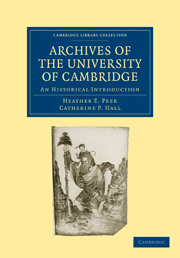Book contents
- Frontmatter
- Contents
- List of Plates
- Preface
- PART I
- PART II
- 4 The University and Colleges as Privileged Corporations
- 5 Records of University Administration
- 6 Records of Matriculation and Degrees
- 7 Financial Records of the University
- 8 Endowments of the University
- 9 University Officers and their Records
- 10 Records of the University Courts
- 11 Records of University Jurisdiction in the Town of Cambridge
- 12 The Relations between the Crown and the University
- 13 Other University Institutions and their Records
- APPENDICES
- Index
- Index to Muniments of Title in Appendix B
- Plate section
11 - Records of University Jurisdiction in the Town of Cambridge
Published online by Cambridge University Press: 07 September 2010
- Frontmatter
- Contents
- List of Plates
- Preface
- PART I
- PART II
- 4 The University and Colleges as Privileged Corporations
- 5 Records of University Administration
- 6 Records of Matriculation and Degrees
- 7 Financial Records of the University
- 8 Endowments of the University
- 9 University Officers and their Records
- 10 Records of the University Courts
- 11 Records of University Jurisdiction in the Town of Cambridge
- 12 The Relations between the Crown and the University
- 13 Other University Institutions and their Records
- APPENDICES
- Index
- Index to Muniments of Title in Appendix B
- Plate section
Summary
Although the university was an autonomous and privileged corporation, keeping, as far as possible, its own functions and members within its own jurisdiction, it could not be entirely independent of another ancient and privileged corporation on its doorstep, the borough of Cambridge. In fact, the borough could claim the greater antiquity, in that its earliest extant charter, that of 1207, antedates the oldest in the university archives by almost sixty years.
In the medieval university, as now, large numbers of scholars lodged in the town and, from its earliest days, the university was concerned to protect its members against extortionate rents, and against poor quality and high prices of provisions, as well as from assault by hostile townsfolk. In cases of breaches of the peace committed by the scholars themselves, which were by no means uncommon among these turbulent and unruly clerks, the university was at pains to keep its offending members from the jurisdiction of the royal justices in eyre and from the cognizance of the borough courts. Even from the sixteenth century, when most members of the university lived in colleges, both collegians and townsfolk walked the same streets, drank the same water and were supplied from the same markets. As the university pressed its claims to protect and control its members in every aspect of their lives, it was inevitable that it should come to interfere largely in the concerns of town and townsmen, and that friction should occur.
- Type
- Chapter
- Information
- Archives of the University of CambridgeAn Historical Introduction, pp. 53 - 64Publisher: Cambridge University PressPrint publication year: 1963First published in: 1962

